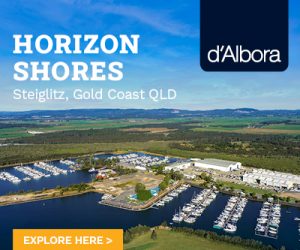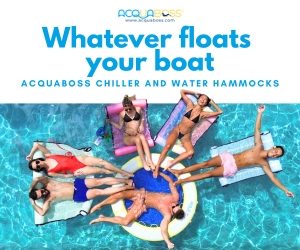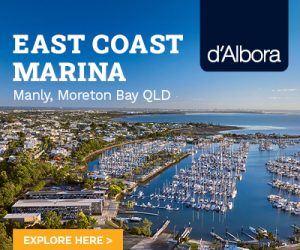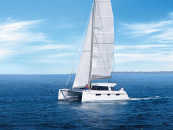EXCEEDING EXPECTATIONS
The idea came about while I was watching the 2017 America’s Cup in Bermuda. The carbon fibre multi-hull foiling catamarans sailing at speeds over 40 knots inspired me to design and build a trailer size boat made from the best materials to exceed the performance of any boat of a similar size.
The name is referenced to an area in Sydney’s Middle Harbour, called Castle Rock. Castle Rock is, in my opinion (after sailing around the world for 14 years), the best stretch of water way for any boat lover. My family have been sailing out of Middle Harbour for many generations and it has been a boating playground throughout my life.
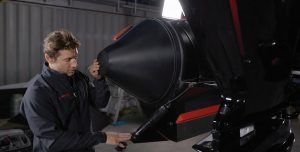 WHY CARBON FIBRE? – Humans have been trying to improve boating technology and engineering for thousands of years, but the carbon fibre industry may just bring our endless search to a halt.
WHY CARBON FIBRE? – Humans have been trying to improve boating technology and engineering for thousands of years, but the carbon fibre industry may just bring our endless search to a halt.
Carbon fibre is made from a process that is part chemical and part mechanical. It starts by drawing long strands of carbon fibres and then heating them to a very high temperature without allowing exposure to oxygen to prevent the fibres from burning.
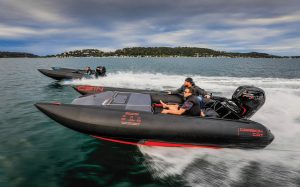 This is when the carbonization takes place, which is when the atoms inside the fibres vibrate violently, expelling most of the non-carbon atoms. This leaves a fibre composed of long, tightly inter-locked chains of carbon atoms with only a few non-carbon atoms remaining.
This is when the carbonization takes place, which is when the atoms inside the fibres vibrate violently, expelling most of the non-carbon atoms. This leaves a fibre composed of long, tightly inter-locked chains of carbon atoms with only a few non-carbon atoms remaining.
On the open water your boat is able to withstand the constant changes in energy.
Carbon fibre manufacturing ensures that the carbon fibre composite has the best sheer strength, tensile strength, and resistance to crushing.
The honeycomb design of carbon fibre threads ensures the matrix is able to remain stiff under pressure. This makes its application suitable for a wide variety of boats. Structural carbon fibre ensures your structure‘s integrity and longevity.
Carbon Cat is made of 100% carbon fibre with minimal through-hull fittings, and is lighter than fibreglass, reducing displacement and saving on fuel. It’s also more rigid, reducing the impact on other components such as deck fixtures. Not only is it stronger, which increases the life expectancy of the boat, its shape also means it doesn’t deteriorate over time or change when constant force is applied. Carbon fibre also has a negative coefficient of thermal expansion, which means it doesn’t expand or shrink as much as fibreglass when temperatures change. It is more rigid than other materials, absorbing most of the impact load away from other components, and it is lighter, thus more economical by saving on fuel.
As for hypalon, it is much more resilient to UV exposure and to accidental gas, oil, or chemical exposure, such as fuel spills, compared to their PVC counterparts. It is so much more resistant to shock and impact. Available in 30 colours and 6 surface finishings in ORCA fabrics. Utilising hypalon and vinyl wrapping allows buyers to choose the design and colour scheme of their choice. These options include a snow camouflage colour scheme and the gloss carbon fibre hull, deck, transom and nose cone finish to create the ultimate carbon look.
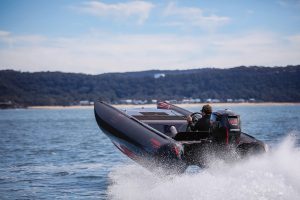 TUNNEL HULL – The tunnel hull design has evolved from two years of sea trials in many different types of sea conditions on the water. The change of wind speed, sea state, swell, and wind and weight onboard are the major factors taken into account when testing to ensure all-round performance.
TUNNEL HULL – The tunnel hull design has evolved from two years of sea trials in many different types of sea conditions on the water. The change of wind speed, sea state, swell, and wind and weight onboard are the major factors taken into account when testing to ensure all-round performance.
As a result of the sea trials, we have modified tunnel height, position and profile of chines, adjusted dead rise angle, and introduced a pod system to the aft under side of the deck to reduce tunnel turbulence.
The design features planing strakes to provide lift and rigidity to the catamaran, which are complemented with a pair of custom carbon fibre-Kevlar trim tabs and outboard jacking plate to adjust ride altitude. The boat is lightweight with a reinforced carbon fibre deck, structure and full hatch, surrounded by a robust hypalon tube to give protection and a dry ride. It is an exhilarating boat that is suitable for all levels of experience.
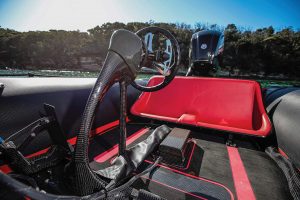 HYDRODYNAMIC AND AERODYNAMIC – The hull coefficient creates great stern lift at high speeds due to the tunnel hull, compressing air as it moves through the tunnel. The Carbon Cat underway has minimal wetted surfaces on the hull that reduces drag and lets the semi-surfacing propellers work at their optimal performance.
HYDRODYNAMIC AND AERODYNAMIC – The hull coefficient creates great stern lift at high speeds due to the tunnel hull, compressing air as it moves through the tunnel. The Carbon Cat underway has minimal wetted surfaces on the hull that reduces drag and lets the semi-surfacing propellers work at their optimal performance.
The Carbon Cat is perfect for recreational boating, spearfishing, towing water sports and racing. It is a great high performance tender for superyachts and the client who has a love for carbon fibre craftsmanship and innovation.
SPECIAL FEATURES
- Onboard, the Ropeye Double TDP and Ropeye loop D4 are used for the lifting points. These fittings are also used for mooring the boat and towing. The Ropeye XXS is used for wiring and other smaller deck fixtures.
- The storage area under the hatch contains the fuel tank, bulkhead storage bags, computer system for the push button gearing, fuel filters, and electronics for the display screen and sound system.
- The boat is also fitted with a polypropylene 80L fuel tank, and shipped with a Simrad chartplotter and compatible Fusion audio system.
- The 5.3m Carbon Cat comes with two steering options: hydraulic tiller steer or an F1-style steering that features paddle shifters for engine trim and jacking plate control as well as foot throttle and push button gearing and ignition.
- The recommended engine for the Carbon Cat is the Mercury Pro XS 115hp 4-Stroke, the lightest 115hp, and provides two gearbox options depending on how you want to use the boat.
- Due to the boat’s minimal displacement below the waterline when underway, the standard engine water intake is above the water line. So, the two options for water pick up to cool the engine are an intake hose running from the starboard trim tab or from a low water nose cone pick-up fitted to the front of the gearbox.
For more information, contact Dan Oatley on enquiry@castlerockcarbon.com
Published in print October-December 2021








